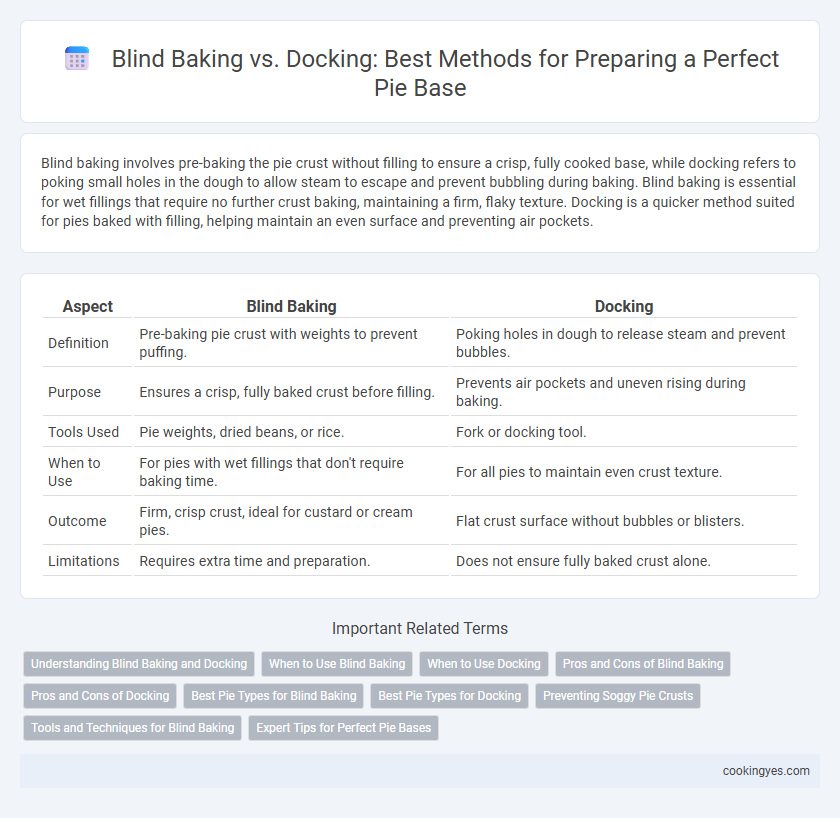Blind baking involves pre-baking the pie crust without filling to ensure a crisp, fully cooked base, while docking refers to poking small holes in the dough to allow steam to escape and prevent bubbling during baking. Blind baking is essential for wet fillings that require no further crust baking, maintaining a firm, flaky texture. Docking is a quicker method suited for pies baked with filling, helping maintain an even surface and preventing air pockets.
Table of Comparison
| Aspect | Blind Baking | Docking |
|---|---|---|
| Definition | Pre-baking pie crust with weights to prevent puffing. | Poking holes in dough to release steam and prevent bubbles. |
| Purpose | Ensures a crisp, fully baked crust before filling. | Prevents air pockets and uneven rising during baking. |
| Tools Used | Pie weights, dried beans, or rice. | Fork or docking tool. |
| When to Use | For pies with wet fillings that don't require baking time. | For all pies to maintain even crust texture. |
| Outcome | Firm, crisp crust, ideal for custard or cream pies. | Flat crust surface without bubbles or blisters. |
| Limitations | Requires extra time and preparation. | Does not ensure fully baked crust alone. |
Understanding Blind Baking and Docking
Blind baking involves pre-baking the pie crust without filling to prevent sogginess, often using pie weights to maintain its shape. Docking entails pricking the dough with a fork to allow steam to escape, reducing bubbles during baking and ensuring an even, flat base. Both techniques are essential for achieving a crisp, well-structured pie base, especially in custard or cream-filled pies.
When to Use Blind Baking
Blind baking is essential when making pies with wet fillings, such as custards or fruit mixtures, to prevent a soggy crust by pre-cooking the base until it is firm and lightly golden. It is also recommended for delicate pie crusts that require extra structure before adding filling or for recipes where the filling has a shorter baking time than the crust. Use blind baking with techniques like weights or beans to maintain the pie crust shape and ensure even cooking without puffing or shrinking.
When to Use Docking
Docking a pie base is essential when baking a crust meant to remain flat and firm, such as for custard or cream pies, to prevent bubbling and uneven rising during blind baking. This technique involves piercing the dough with a fork or docking tool, allowing steam to escape and ensuring a smooth, even surface. Use docking specifically when the pie filling is added after baking and does not require the crust to puff or rise.
Pros and Cons of Blind Baking
Blind baking a pie crust ensures a crisp, fully cooked base, preventing sogginess from wet fillings, while also preserving the pie's structural integrity during baking. It requires extra time and careful monitoring to avoid overbaking or shrinkage, posing a risk for delicate doughs. This method is particularly effective for recipes with no-bake or custard fillings, balancing texture precision with preparation complexity.
Pros and Cons of Docking
Docking a pie crust involves pricking the dough with a fork to create small holes, which helps prevent air bubbles and uneven rising during baking. This method is advantageous because it allows steam to escape, resulting in a uniformly flat and crisp base, ideal for wet fillings. However, docking may not be suitable for all pie types, as it can cause excessive shrinkage or compromise the dough's structural integrity in recipes requiring a puffier crust.
Best Pie Types for Blind Baking
Blind baking is ideal for pies with wet fillings like custard, cream, or fruit to prevent soggy crusts, making it perfect for custard pies, key lime pies, and pumpkin pies. Docking involves pricking the dough to release steam and is more suitable for flaky pastry tart shells or dry fillings like nuts and chocolate. Choosing blind baking ensures a crisp, fully baked crust that holds up well under moist or delicate fillings.
Best Pie Types for Docking
Docking is ideal for pie bases with wet or custard fillings, such as pumpkin, pecan, or quiche pies, as it prevents bubbling and ensures even baking by allowing steam to escape. Unlike blind baking, which fully cooks the crust beforehand, docking lightly pierces the dough to maintain a tender but crisp texture. This technique is less suitable for flaky or buttery crusts intended for dry fillings, where blind baking better preserves structure.
Preventing Soggy Pie Crusts
Blind baking involves pre-baking the pie crust with pie weights or beans to set the structure and prevent sogginess by creating a firm barrier against moist fillings. Docking, which means pricking holes in the dough with a fork, allows steam to escape during baking, reducing bubbles and ensuring an evenly crisp crust. Combining blind baking and docking techniques offers the most effective way to achieve a perfectly crisp and non-soggy pie base.
Tools and Techniques for Blind Baking
Blind baking a pie crust requires using pie weights, ceramic beads, or dried beans to prevent the dough from puffing during baking. A perforated pie pan or a baking sheet lined with parchment paper supports even heat distribution and crust structure. Docking, on the other hand, involves pricking the dough with a fork to allow steam to escape but does not replace the need for weights in blind baking.
Expert Tips for Perfect Pie Bases
Blind baking ensures a crisp pie base by pre-baking the crust with pie weights or dried beans to prevent puffing and shrinking, crucial for custard or cream pies. Docking the dough by pricking it with a fork allows steam to escape, reducing the risk of bubbles and uneven baking, ideal for flaky pastry crusts. Experts recommend chilling the dough before blind baking and combining both techniques for optimal texture and stability.
Blind Baking vs Docking for Pie Base Preparation Infographic

 cookingyes.com
cookingyes.com